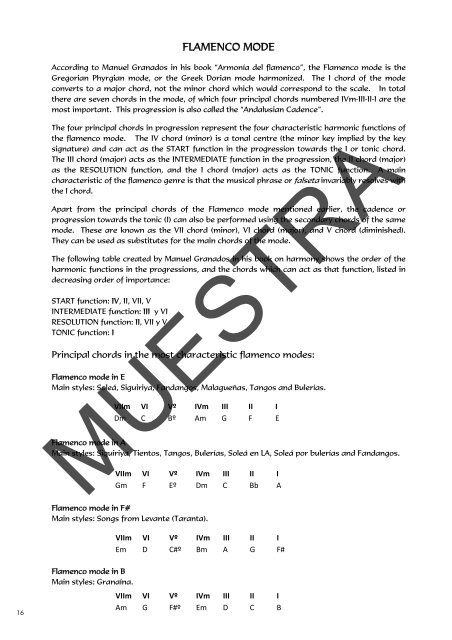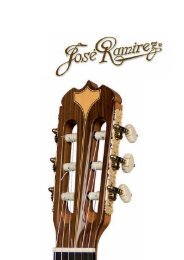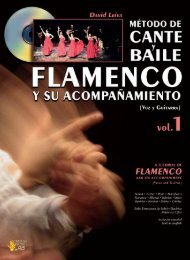You also want an ePaper? Increase the reach of your titles
YUMPU automatically turns print PDFs into web optimized ePapers that Google loves.
16<br />
FLAMENCO MODE<br />
According to Manuel Granados in his book “Armonía del flamenco”, the Flamenco mode is the<br />
Gregorian Phyrgian mode, or the Greek Dorian mode harmonized. The I chord of the mode<br />
converts to a major chord, not the minor chord which would correspond to the scale. In total<br />
there are seven chords in the mode, of which four principal chords numbered IVm-III-II-I are the<br />
most important. This progression is also called the “Andalusian Cadence”.<br />
The four principal chords in progression represent the four characteristic harmonic functions of<br />
the flamenco mode. The IV chord (minor) is a tonal centre (the minor key implied by the key<br />
signature) and can act as the START function in the progression towards the I or tonic chord.<br />
The III chord (major) acts as the INTERMEDIATE function in the progression, the II chord (major)<br />
as the RESOLUTION function, and the I chord (major) acts as the TONIC function. A main<br />
characteristic of the flamenco genre is that the musical phrase or falseta invariably resolves with<br />
the I chord.<br />
Apart from the principal chords of the Flamenco mode mentioned earlier, the cadence or<br />
progression towards the tonic (I) can also be performed using the secondary chords of the same<br />
mode. These are known as the VII chord (minor), VI chord (major), and V chord (diminished).<br />
They can be used as substitutes for the main chords of the mode.<br />
The following table created by Manuel Granados in his book on harmony shows the order of the<br />
harmonic functions in the progressions, and the chords which can act as that function, listed in<br />
decreasing order of importance:<br />
START function: IV, II, VII, V<br />
INTERMEDIATE function: III y VI<br />
RESOLUTION function: II, VII y V<br />
TONIC function: I<br />
Principal chords in the most characteristic flamenco modes:<br />
Flamenco mode in E<br />
Main styles: Soleá, Siguiriya, Fandangos, Malagueñas, Tangos and Bulerías.<br />
VIIm� VI� Vº� IVm� III� II� I�<br />
Dm�<br />
�<br />
Flamenco mode in A<br />
C� Bº� Am� G� F� E�<br />
Main styles: Siguiriya, Tientos, Tangos, Bulerías, Soleá en LA, Soleá por bulerías and Fandangos.<br />
MUESTRA<br />
VIIm� VI� Vº� IVm� III� II� I�<br />
Gm�<br />
�<br />
Flamenco mode in F#<br />
F� Eº� Dm� C� Bb� A�<br />
Main styles: Songs from Levante (Taranta).<br />
VIIm� VI� Vº� IVm� III� II� I�<br />
Em�<br />
�<br />
Flamenco mode in B<br />
Main styles: Granaína.<br />
D� C#º� Bm� A� G� F#�<br />
VIIm� VI� Vº� IVm� III� II� I�<br />
Am� G� F#º� Em� D� C� B�






